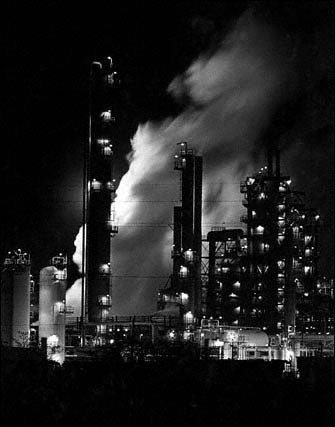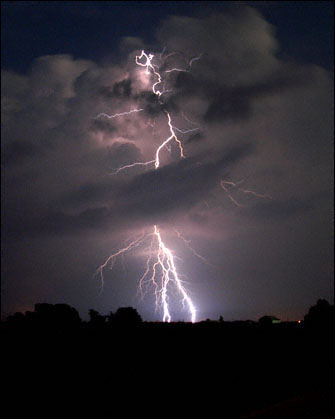Steam, 1976 (Kodak Tri-X film)
This is an oldie of the Marathon Oil Refinery in Robinson. I guess you could say it is the one that launched my career, because it won every amateur photo contest it was entered in. That gave me the confidence and inspiration to keep going. It was made on Kodak Tri-X film on a cold winter night in 1976. As I recall, the exposure was about 20 seconds long at about f/22. The long exposure causes the steam to take on a cotton-candy-like appearance. The contest judges all overlooked the power lines that look like scratches in the lower left. An earlier attempt to make this photo failed. The sky was cloudy that night and the refinery lights reflecting from them made the sky gray and the steam just merged into it. I went back a few nights later when there were no clouds and used an exposure combination I had found on the cloudy night.
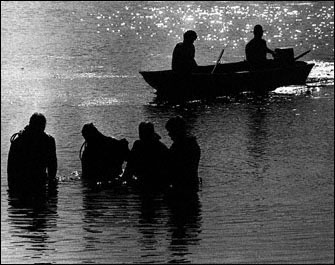
Drowning (Kodak Tri-X film)
This, I feel, is an example of finding something artful in a news story. When I came back with this photo I remember the Daily News editor, Byron Tracy, looking at it and asking me how I could go to something so tragic and come back with something so artistic. It shows four divers standing in the water and a boat with an Indiana State Police officer and a volunteer as the search for a drowning victim is ended for the day. This was taken in July 1978 on the Indiana side of the “Dead River Lake” across the Wabash River from Hutsonville, Illinois. A dead river is a lake created when a river changes its channel and seals off the old channel from the main body of the river. It had been a long afternoon and evening of searching for the victim, and I felt the posture of the divers showed the strain and exhaustion they experienced. The low angle of the sun gives an indication of the lateness of the day. The body was recovered the next morning.
Boom (Kodak Tri-X film)
This photo of the demolition of the Hutsonville Bridge was taken on Nov. 23, 1988 with a radio-controlled camera. I had to work with the demolition company to make sure my radio would not interfere with their communication equipment or the explosives. I pulled a servo and receiver out of an RC airplane I had and built a device to trip the shutter release of the motor-driven camera shooting about 4 frames per second. The camera was on a tripod that was lashed behind a guardrail on the new bridge. The camera was triggered when the countdown hit “one.” As I recall this is about the twelfth frame on the roll. There is a bit of irony in this event. My mother was in the grade school chorus that sang at the bridge’s dedication in 1939 and I was the only photographer allowed to place a camera this close to it when it was blown up.
Prairie Storm (Digital image)
Mother Nature put on quite a light show this past August 18. I live in Ashmore, and that night the lighting was flashing but the thunder was distant. I grabbed the camera and tripod and drove about a mile east of Ashmore on Charleston Road. The lighting strikes were coming out of this cloud about once every 20 seconds so I decided that if I made 30-second exposures I would probably have at least one lightning bolt on every frame. There was a clear sky over my location and a very bright full moon was illuminating the cloud. This was a problem. If I made an exposure long enough to catch a lightning bolt there was a good chance the moon would illuminate the cloud to the point that it would look like cotton candy and not hold any detail. I needed to find a lens aperture that would allow exposure of the lighting, but not expose the cloud until the lighting flashed. In other words, the lighting would act like a giant strobe light to illuminate the cloud.
And I did not want to spend all night taking 30-second exposures to figure out an aperture to do the job, because more storms were forming behind me and to the north and I was out on open ground with a metal tripod. Since I shoot with a digital camera this problem was easily solved. I started making 7-second exposures at every lens opening. I looked at them and picked the first one that was nearly totally black. It was at f/4. Since lengthening the exposure to 30 seconds is an increase of about two exposure factors I closed the lens two f/stops. The exposure was then 30 seconds at f/8. There is still some movement visible in the cloud, but it is minimal.
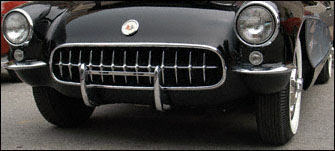
“Say cheeeeeeeeze!” (Digital image)
Every July the Twin Lakes Car Club at Paris hosts a cruise-in that packs the streets around the courthouse with cars. When viewed at an eye-to-headlight angle this freshly restored 1957 Corvette reminded me of a kid with braces grinning from ear to ear. Or should it be headlight to headlight?

Carnival 2004 No. 3 (Digital image)
I love carnivals. They are just packed with opportunities for interesting photos. For this image, taken at dusk one evening at the 2004 Coles County Fair, the camera was placed on a tripod and the shutter was left open for 8 seconds. The merry-go-round and the people in the foreground were not moving but the Ferris wheel obviously was, creating a juxtaposition of motion.
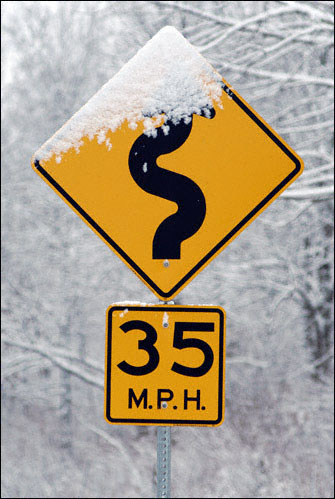
Sign of Winter (Digital image)
Before sunrise on January 8th I had to bring my oldest son to Charleston High School to catch a bus to a chess tournament. A heavy, clinging snow had fallen overnight. After getting A.J. on the bus I returned home to Ashmore, brewed some coffee and waited for the sun to rise. I left, camera in hand, as soon as the sky started to lighten. The light was beautiful that morning; filtered through an unchanging moderate overcast. I took a few pictures in and around Ashmore, then along Route 16 where I had spotted some possible photo opportunities when I took my son to the high school. I turned onto Outer East Harrison and took it back toward the river. As I approached the river from the west I found this scene. I could not escape being drawn to the contrast created by the snow on the yellow sign and its black curves symbol.

No. 3 (Digital image)
I shoot Premier Boys State for the Illinois American Legion every year. I was walking across the South Quad during the 2004 event and I happened to look up as I went past the flagpole. A light breeze was blowing. It did not have enough energy to completely unfurl the flag and I suddenly realized I had never seen a flag from quite that angle. I stood there, camera up and ready, for probably three minutes waiting on the breeze to create this view.
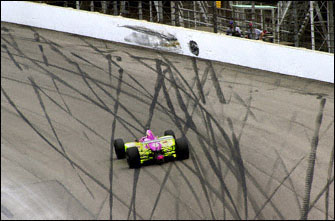
Skids (Digital image)
I photographed every Indianapolis 500 between 1978 and 2000 from a spot at the exit of Turn 1. In 2002, on the first day of qualifications, I was there at the race just as a spectator, and got to wondering what the view from above Turn 1 was like. It seemed like a lot of drivers were having problems getting through that turn that day and during practice on the days leading up to qualifications. I decided to venture from the stands behind pit road where I was seated to the outside of the track and up to the top deck of the Turn 1 grandstand, known as K Stand. I had a suspicion that the skid marks on the track might make for an interesting photo. If maintenance crews did not paint over the hit marks on the wall every night there would be at least three more visible in this photo. None of the drivers involved in these accidents were injured thanks to the safety features built into Indy cars. In fact, every driver involved in these incidents was back on the track in another car within two hours.
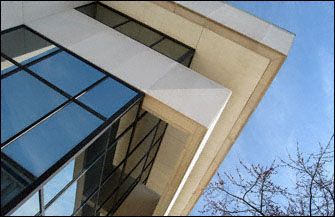
Lumpkin No. 5 (Digital image)
Being a photographer means seeing things most people do not see. Everyone on campus knows where the Lumpkin Building is and what it looks like, but do they “see” it? Do they ever notice how the lines and sharp corners, the contrasting textures of stone versus glass and the layered facades jut into a blue spring sky when the building is viewed from the sidewalk at the southwest corner?
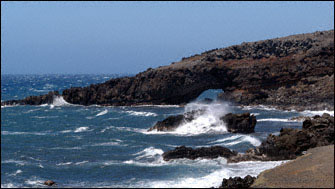
Lava Bridge No. 4 (Digital image)
This scene is on the southeast shore of Maui, in an area most tourists do not see because insurance on rental cars is invalidated by travel on the road that goes here. This region is a desert with narrow roads made of loose, fist-sized stones. The wind blows in unchecked from across thousands of miles of the Pacific. The surf is violent. Mount Haleakala, which last erupted in 1790 and sent this finger of lava into the ocean, looms 10,000 feet above this beach. And standing there and looking at this scene reminded me of just how small humans are on this planet. Sea, sky and lava … this is where it all started.
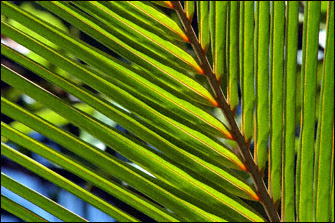
Palm No. 1 (Digital image)
Everyone who visits a tropical island sees plenty of palms, but how many actually stop to see the palm? The strong backlight helped accentuate the symmetry of this plant. This was taken on Maui, near the grave of Charles Lindbergh at the Ho’omau Church Cemetery overlooking Kipahulu Bay.
